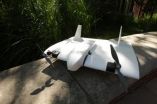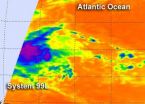(Press-News.org) Archaeological sites that currently take years to map will be completed in minutes if tests underway in Peru of a new system being developed at Vanderbilt University go well.
The Aurora Flight Sciences unmanned aerial vehicle will be integrated into a larger system that combines the flying device that can fit into a backpack with a software system that can discern an optimal flight pattern and transform the resulting data into three-dimensional maps. The project is an interdisciplinary collaboration between Vanderbilt archaeologist Steven Wernke and engineering professor Julie A. Adams.
They call it SUAVe – for Semi-autonomous Unmanned Aerial Vehicle. It was partially financed by an Interdisciplinary Discovery Grant from Vanderbilt.
"It can take two or three years to map one site in two dimensions," Wernke said. "The SUAVe (pronounced SWAH-vey) system should transform how we map large sites that take several seasons to document using traditional methods. It will provide much higher resolution imagery than even the best satellite imagery, and it will produce a detailed three-dimensional model."
The SUAVe system is compact and is designed to be easy to use.
"You will unpack it, specify the area that you need it to cover and then launch it," Wernke said. "When it completes capturing the images, it lands and the images are downloaded, matched into a large mosaic, and transformed into a map."
The algorithms developed for the project allow the SUAVe system to specify the flight pattern to compensate for factors such as the wind speed, the angle of the sun and photographic details like image overlap and image resolution, Adams said.
"The only way for this system to be cost-effective is for it to be easy enough to operate that you don't need an engineer on every site," Adams said. "It has to be useable without on-site technical help."
Tests are scheduled from mid-July to mid-August at the abandoned colonial era town of Mawchu Llacta in Peru, and plans call to return next year after any issues that arise are addressed in the lab.
Built in the 1570s at a former Inca settlement and mysteriously abandoned in the 19th century, the village of Mawchu is a 45-minute hike for the team from the nearby village of Tuti. Mawchu Llacta is composed of standing architecture arranged in regular blocks covering about 25 football fields square.
"Archaeology is a spatial discipline," Wernke said. "We depend on accurate documentation of not just what artifacts were used in a given time period, but how they were used in their cultural context. In this sense, SUAVe can provide a fundamental toolset of wide significance in archaeological research."
Wernke hopes that the new technology will allow many archaeological sites to be catalogued very quickly, since many are being wiped away by development and time.
"The SUAVe system should be a way to create a digital archival registry of archaeological sites before it's too late," he said. "It will likely create the far more positive problem of having so much data that it will take some time go through it all properly."
SUAVe could also have other applications, including the tracking of the progress of global warming and as a tool for first responders at disaster sites.
"The device would be an excellent tool for evaluating the site of a major crisis such as Sept. 11 to decide how to deploy lifesaving resources more effectively," Adams said.
INFORMATION:
This research was partially supported by an NSF CAREER award, NSF #IIS-0643100.
Test flight over Peru ruins could revolutionize archaeological mapping
2012-08-02
ELSE PRESS RELEASES FROM THIS DATE:
In pilot study, a peptide controls blood sugar in people with congenital hyperinsulinism
2012-08-02
A pilot study in adolescents and adults has found that an investigational drug shows promise as the first potential medical treatment for children with the severest type of congenital hyperinsulinism, a rare but potentially devastating disease in which gene mutations cause insulin levels to become dangerously high.
"There is currently no effective medicine for children with the most common and most severe form of hyperinsulinism," said study leader Diva D. De Leon, M.D., a pediatric endocrinologist at The Children's Hospital of Philadelphia. "Our new research shows that ...
NASA satellite sees strength in developing Atlantic tropical low
2012-08-02
NASA's Aqua satellite spotted some very cold, high, thunderstorms around the center of a tropical low pressure area in the Atlantic Ocean today, indicating that the system is getting stronger and more organized.
The low pressure area, designated as "System 99L" was located about 850 miles east of the southern Windward Islands, near 10.7 North latitude and 46.9 West longitude. It was moving west between 15 and 20 mph.
NASA's Aqua satellite passed over System 99L on August 1 at 0405 UTC (12:05 a.m. EDT) and the Atmospheric Infrared Sounder (AIRS) instrument captured an ...
Caffeine may ease Parkinson's symptoms
2012-08-02
Montreal, August 1, 2012 – Caffeine, which is widely consumed around the world in coffee, tea and soft drinks, may help control movement in people suffering from Parkinson's. This is the finding of a study conducted at the Research Institute of the McGill University Health Centre (RI MUHC) that was recently published in Neurology®, the official journal of the American Academy of Neurology. The study opens the door to new treatment options for Parkinson's disease that affects approximately 100 000 Canadians.
"This is one of the first studies to show the benefits of caffeine ...
Researchers discover female spiders produce mating plugs to prevent unwanted sex from males
2012-08-02
Scientists at the Smithsonian and their colleagues have discovered a new mechanism of animal mating plug production. In the giant wood spider Nephila pilipes, a highly sexually dimorphic and polygamous species, many small males compete with one other for access to a few huge females. During copulation these males are known to sever their own genitals in an attempt to plug the female, thereby gaining paternity advantage by preventing other males from mating with her.
Until recently however, nothing has been known about the origin and function of additional and very solid ...
NASA sees twin typhoons headed for double China landfall
2012-08-02
NASA's Terra satellite captured two tropical cyclones on visible imagery today, August 1 as they head for landfall. Typhoon Saola is approaching Taiwan and Typhoon Damrey approaching southern Japan, are both headed for landfall in China. Saola is forecast to landfall south of Shanghai on August 3, while Damrey is forecast to make landfall north of Shanghai on August 2.
NASA satellites have been tracking the twin tropical troublemakers, providing forecasters at the Joint Typhoon Warning Center with visible, infrared and microwave imagery. The Moderate Resolution Imaging ...
Wrecks and effects
2012-08-02
A study by a University of Iowa economist finds that many car race fans do, indeed, watch NASCAR races because they want to see car wrecks, but more of them have been tuning in to see who actually wins the race since the circuit adopted its Chase for the Cup championship series in 2004.
John Solow, a professor of economics in the Tippie College of Business, and co-author Peter Von Allmen of Skidmore College, looked at 135 NASCAR races between 2001 and 2009. They used a formula that measured the impact on each race's television ratings by incorporating a dozen statistics, ...
Writing graphics software gets much easier
2012-08-02
Image-processing software is a hot commodity: Just look at Instagram, a company built around image processing that Facebook is trying to buy for a billion dollars. Image processing is also going mobile, as more and more people are sending cellphone photos directly to the Web, without transferring them to a computer first.
At the same time, digital-photo files are getting so big that, without a lot of clever software engineering, processing them would take a painfully long time on a desktop computer, let alone a cellphone. Unfortunately, the tricks that engineers use to ...
Google it?: Internet searches often provide inaccurate information about infant sleep safety
2012-08-02
Cincinnati, OH, August 2, 2012 – In 2010, 59% of the U.S. population used internet searches for health information, and parents searching for information regarding their children were among the top users. In 2011, the American Academy of Pediatrics (AAP) published recommendations for infant sleep safety to reduce the risk of sudden infant death syndrome (SIDS), suffocation, strangulation, and other accidental sleep-related deaths. However, according to a study scheduled for publication in The Journal of Pediatrics, Google internet searches related to infant sleep safety ...
HCOs find risks & opportunities in quest for reduced costs & improved quality
2012-08-02
Rochester, MN, August 2, 2012 – Many health care systems across the US have declined to participate in the Centers for Medicare and Medicaid Services' (CMMS) Accountable Care Organization (ACO) program, developed under the Patient Protection and Affordable Care Act (PPACA), to improve efficiency and quality of health care delivery. In a groundbreaking collection of commentaries in the current issue of Mayo Clinic Proceedings, representatives of six leading health care organizations write about the challenges of reducing health care costs while improving health care quality. ...
Neutron scattering explains how myoglobin can perform without water
2012-08-02
Proteins do not need to be surrounded by water to carry out their vital biological functions, according to scientists from the Institut de Biologie Structurale (IBS) in Grenoble, the University of Bristol, the Australian National University, the Institut Laue Langevin and the Jülich Centre for Neutron Science.
In a new paper, published in the Journal of the American Chemical Society, the team used a state-of-the-art neutron scattering technique to demonstrate that when myoglobin, an oxygen-binding protein found in the muscle tissue of vertebrates, is enclosed in a sheath ...


